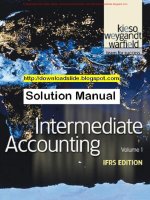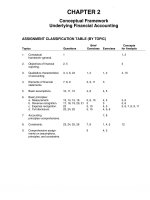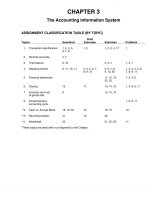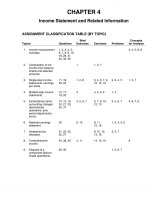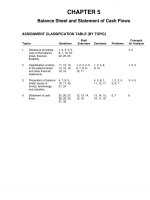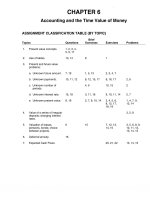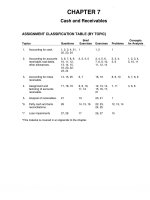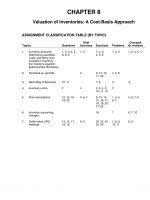Solution manual intermediate accounting 13e kieso ch04
Bạn đang xem bản rút gọn của tài liệu. Xem và tải ngay bản đầy đủ của tài liệu tại đây (466.36 KB, 78 trang )
To download more slides, ebook, solutions and test bank, visit
CHAPTER 4
Income Statement and Related Information
ASSIGNMENT CLASSIFICATION TABLE (BY TOPIC)
Topics
1.
Income measurement
concepts.
2.
Computation of net
income from balance
sheets and selected
accounts.
3.
Single-step income
statements; earnings
per share.
4.
Questions
Brief
Exercises
Exercises
Problems
1, 2, 3, 4, 5,
6, 7, 8, 9, 10,
18, 28, 31,
32, 33, 36
3, 4, 5, 6, 8
1
1, 2, 7
11, 19,
23, 24
1, 2, 8
3, 4, 6, 7, 9,
10, 12, 16
2, 3, 4, 5
Multiple-step income
statements.
12, 17,
19, 20
3
4, 5, 6, 8
1, 4
5.
Extraordinary items;
accounting changes;
discontinued
operations; prior
period adjustments;
errors.
13, 14, 15,
16, 27, 29,
35, 37
4, 5, 6, 7
5, 7, 9, 10,
12, 13
3, 5, 6, 7
6.
Retained earnings
statement.
30
9, 10
8, 11,
15, 16
1, 2, 4, 5, 6
7.
Intraperiod tax
allocation.
21, 22, 25,
26, 27
8, 10, 12,
13, 16
3, 5, 7
8.
Comprehensive
income.
34, 38, 39
9.
Disposal of a
component (discontinued operations).
29, 35
Copyright © 2010 John Wiley & Sons, Inc.
Concepts
for Analysis
4, 11
14, 15, 16
Kieso, Intermediate Accounting, 13/e, Solutions Manual
1, 2, 7
4, 6, 7, 8
9
1, 3, 6, 7
(For Instructor Use Only)
4-1
To download more slides, ebook, solutions and test bank, visit
ASSIGNMENT CLASSIFICATION TABLE (BY LEARNING OBJECTIVE)
Brief
Exercises
Learning Objectives
Exercises
Problems
1.
Understand the uses and limitations
of an income statement.
2.
Prepare a single-step income statement.
1, 2
1, 2, 3, 4,
6, 7, 16
2
3.
Prepare a multiple-step income statement.
3, 4
4, 5, 6, 8,
10, 14
1, 4
4.
Explain how to report irregular items.
4, 5, 6, 7, 10
5, 7, 8, 10,
12, 13, 16
1, 3, 4, 5,
6, 7
5.
Explain intraperiod tax allocation.
5
8, 10, 12,
13, 16
1, 3, 5, 6, 7
6.
Identify where to report earnings per share
information.
8
7, 8, 9, 10,
12, 13, 16
1, 2, 3, 4,
5, 7
7.
Prepare a retained earnings statement.
9, 10
8, 11, 15, 16
1, 2, 4, 5, 6
8.
Explain how to report other comprehensive
income.
11
14, 15, 16
4-2
Copyright © 2010 John Wiley & Sons, Inc.
Kieso, Intermediate Accounting, 13/e, Solutions Manual
(For Instructor Use Only)
To download more slides, ebook, solutions and test bank, visit
ASSIGNMENT CHARACTERISTICS TABLE
Level of
Difficulty
Time
(minutes)
Simple
Simple
Moderate
Simple
Moderate
Moderate
Simple
Simple
Simple
Moderate
18–20
25–35
20–25
30–35
30–35
30–40
15–20
30–35
20–25
20–25
E4-11
E4-12
E4-13
E4-14
E4-15
E4-16
Computation of net income.
Income statement items.
Single-step income statement.
Multiple-step and single-step.
Multiple-step and extraordinary items.
Multiple-step and single-step.
Income statement, EPS.
Multiple-step statement with retained earnings.
Earnings per share.
Condensed income statement—periodic inventory
method.
Retained earnings statement.
Earnings per share.
Change in accounting principle.
Comprehensive income.
Comprehensive income.
Various reporting formats.
Simple
Moderate
Moderate
Simple
Moderate
Moderate
20–25
15–20
15–20
15–20
15–20
30–35
P4-1
P4-2
P4-3
P4-4
P4-5
P4-6
P4-7
Multi-step income, retained earnings.
Single-step income, retained earnings, periodic inventory.
Irregular items.
Multiple- and single-step income, retained earnings.
Irregular items.
Retained earnings statement, prior period adjustments.
Income statement, irregular items.
Moderate
Simple
Moderate
Moderate
Moderate
Moderate
Moderate
30–35
25–30
30–40
45–55
20–25
25–35
25–35
CA4-1
CA4-2
CA4-3
CA4-4
CA4-5
CA4-6
CA4-7
CA4-8
CA4-9
Identification of income statement deficiencies.
Income reporting deficiencies.
Extraordinary items.
Earnings management.
Earnings management
Income reporting items.
Identification of income statement weaknesses.
Classification of income statement items.
Comprehensive income.
Simple
Simple
Moderate
Moderate
Simple
Moderate
Moderate
Moderate
Simple
20–25
10–15
20–25
20–25
15–20
30–35
30–40
20–25
10–15
Item
E4-1
E4-2
E4-3
E4-4
E4-5
E4-6
E4-7
E4-8
E4-9
E4-10
Description
Copyright © 2010 John Wiley & Sons, Inc.
Kieso, Intermediate Accounting, 13/e, Solutions Manual
(For Instructor Use Only)
4-3
To download more slides, ebook, solutions and test bank, visit
SOLUTIONS TO CODIFICATION EXERCISES
CE4-1
According to the Glossary:
(a) A change in accounting estimate is a change that has the effect of adjusting the carrying amount
of an existing asset or liability or altering the subsequent accounting for existing or future assets or
liabilities. Changes in accounting estimates result from new information. Examples of items for
which estimates are necessary are uncollectible receivables, inventory obsolescence, service lives
and salvage value of depreciable assets, and warranty obligations. A change in accounting estimate
is a necessary consequence of the assessment, in conjunction with the periodic presentation of
financial statements, of the present status and expected future benefits and obligations associated
with assets and liabilities.
(b) A change in accounting principle reflects a change from one generally accepted accounting
principle to another generally accepted accounting principle when there are two or more generally
accepted accounting principles that apply or when the accounting principle formerly used is no
longer generally accepted. A change in the method of applying an accounting principle also is
considered a change in accounting principle. A “Change in Accounting Estimate Effected by a
Change in Accounting Principle” is a change in accounting estimate that is inseparable from the
effect of a related change in accounting principle. An example of a change in estimate effected by
a change in principle is a change in the method of depreciation, amortization, or depletion for longlived, nonfinancial assets.
(c)
Comprehensive Income is defined as the change in equity (net assets) of a business during a
period from transactions and other events and circumstances from nonowner sources. It includes
all changes in equity during a period except those resulting from investments by owners and
distributions to owners.
CE4-2
The master glossary provides the term “Unusual Nature”, a link from which yields the following:
Glossary Term Usage
The glossary term is used in the following locations.
Unusual Nature
•
225 Income Statement > 20 Extraordinary and Unusual Items > 45 Other Presentation
– 225 Income Statement > 20 Extraordinary and Unusual Items > 45 Other Presentation >
General, paragraph 45-2.
Following this link yields the following paragraph:
45-2 Extraordinary items are events and transactions that are distinguished by their unusual nature
and by the infrequency of their occurrence. Thus, both of the following criteria shall be met to
classify an event or transaction as an extraordinary item:
a.
4-4
Unusual nature. The underlying event or transaction should possess a high degree of
abnormality and be of a type clearly unrelated to, or only incidentally related to, the ordinary
and typical activities of the entity, taking into account the environment in which the entity
operates (see paragraph 225-20-55-1).
Copyright © 2010 John Wiley & Sons, Inc.
Kieso, Intermediate Accounting, 13/e, Solutions Manual
(For Instructor Use Only)
To download more slides, ebook, solutions and test bank, visit
CE4-2 (Continued)
b.
Infrequency of occurrence. The underlying event or transaction should be of a type that
would not reasonably be expected to recur in the foreseeable future, taking into account the
environment in which the entity operates (see paragraph 225-20-55-2).
Thus, “unusual nature” is one of the criterion that determines whether an item meets the
definition of an extraordinary item.
CE4-3
By entering “extraordinary item” and “interim” into the search window, yields the following guidance
(FASB ASC 225-20-50-4):
Interim Reporting
50-4 As indicated in paragraph FASB ASC 270-10-50-5, extraordinary items shall be disclosed
separately and included in the determination of net income for the interim period in which they
occur. In determining materiality, extraordinary items shall be related to the estimated income for
the full fiscal year. Effects of disposals of a component of an entity and unusual and infrequently
occurring transactions and events that are material with respect to the operating results of the
interim period but that are not designated as extraordinary items in the interim statements shall
be reported separately. In addition, matters such as unusual seasonal results and business
combinations shall be disclosed to provide information needed for a proper understanding of
interim financial reports. Extraordinary items, gains or losses from disposal of a component of an
entity, and unusual or infrequently occurring items shall not be pro-rated over the balance of the
fiscal year.
CE4-4
By entering “effect of preferred stock” in the search window yields the following link (FASB ASC
260-10-S55): 260 Earnings per Share > 10 Overall > S55 Implementation Guidance and Illustrations.
General
Effect of Preferred Stock Dividends and Accretion of Carrying Amount of Preferred Stock on Earnings
Per Share S55-1 See paragraph 225-10-S99-5, SAB . . . views on this topic.
Following that link yields the following guidance:
Income or Loss Applicable to Common Stock
S99-5 The following is the text of SAB Topic 6.B, Accounting Series Release 280—General Revision Of
Regulation S-X: Income Or Loss Applicable To Common Stock.
Facts: A registrant has various classes of preferred stock. Dividends on those preferred stocks
and accretions of their carrying amounts cause income applicable to common stock to be less
than reported net income.
Question: In ASR 280, the Commission stated that although it had determined not to mandate
presentation of income or loss applicable to common stock in all cases, it believes that disclosure of that amount is of value in certain situations. In what situations should the amount be
reported, where should it be reported, and how should it be computed?
Copyright © 2010 John Wiley & Sons, Inc.
Kieso, Intermediate Accounting, 13/e, Solutions Manual
(For Instructor Use Only)
4-5
To download more slides, ebook, solutions and test bank, visit
CE4-4 (Continued)
Interpretive Response: Income or loss applicable to common stock should be reported on the
face of the income statement (FN1) when it is materially different in quantitative terms from
reported net income or loss (FN2) or when it is indicative of significant trends or other qualitative
considerations. The amount to be reported should be computed for each period as net income
or loss less: (a) dividends on preferred stock, including undeclared or unpaid dividends if
cumulative; and (b) periodic increases in the carrying amounts of instruments reported as
redeemable preferred stock (as discussed in Topic 3.C) or increasing rate preferred stock (as
discussed in Topic 5.Q).
(FN1) If a registrant elects to follow the encouraged disclosure discussed in paragraph 23 of
Statement 130, and displays the components of other comprehensive income and the total for
comprehensive income using a one-statement approach, the registrant must continue to follow
the guidance set forth in the SAB Topic. One approach may be to provide a separate
reconciliation of net income to income available to common stock below comprehensive income
reported on a statement of income and comprehensive income.
(FN2) The assessment of materiality is the responsibility of each registrant. However, absent
concerns about trends or other qualitative considerations, the staff generally will not insist on the
reporting of income or loss applicable to common stock if the amount differs from net income or
loss by less than ten percent.
4-6
Copyright © 2010 John Wiley & Sons, Inc.
Kieso, Intermediate Accounting, 13/e, Solutions Manual
(For Instructor Use Only)
To download more slides, ebook, solutions and test bank, visit
ANSWERS TO QUESTIONS
1. The income statement is important because it provides investors and creditors with information
that helps them predict the amount, timing, and uncertainty of future cash flows. It helps investors
and creditors predict future cash flows in a number of different ways. First, investors and creditors can
use the information on the income statement to evaluate the past performance of the enterprise.
Second, the income statement helps users of the financial statements to determine the risk (level of
uncertainty) of income—revenues, expenses, gains, and losses—and highlights the relationship
among these various components.
It should be emphasized that the income statement is used by parties other than investors and
creditors. For example, customers can use the income statement to determine a company’s ability
to provide needed goods or services, unions examine earnings closely as a basis for salary discussions, and the government uses the income statements of companies as a basis for formulating
tax and economic policy.
2. Information on past transactions can be used to identify important trends that, if continued, provide
information about future performance. If a reasonable correlation exists between past and future
performance, predictions about future earnings and cash flows can be made. For example, a loan
analyst can develop a prediction of future performance by estimating the rate of growth of past
income over the past several periods and project this into the next period. Additional information
about current economic and industry factors can be used to adjust the trend rate based on
historical information.
3. Some situations in which changes in value are not recorded in income are:
(a) Unrealized gains or losses on available-for-sale investments,
(b) Changes in the market values of long-term liabilities, such as bonds payable,
(c) Changes (increases) in value of property, plant and equipment, such as land, natural resources,
or equipment,
(d) Changes (increases) in the values of intangible assets such as customer goodwill, brand value,
or intellectual capital.
Note that some of these omissions arise because the items (e.g., brand value) are not recognized
in financial statements, while others (value of land) are recorded in financial statements but measurement is at historical cost.
4. Some situations in which application of different accounting methods or estimates lead to comparison
problems include:
(a) Inventory methods—LIFO vs. FIFO,
(b) Depreciation Methods—straight-line vs. accelerated,
(c) Accounting for long-term contracts—percentage-of-completion vs. completed-contract,
(d) Estimates of useful lives or salvage values for depreciable assets,
(e) Estimates of bad debts,
(f) Estimates of warranty costs.
5. The transaction approach focuses on the activities that have occurred during a given period and
instead of presenting only a net change, a description of the components that comprise the change
is included. In the capital maintenance approach, only the net change (income) is reflected whereas
the transaction approach not only provides the net change (income) but the components of income
(revenues and expenses). The final net income figure should be the same under either approach
given the same valuation base.
Copyright © 2010 John Wiley & Sons, Inc.
Kieso, Intermediate Accounting, 13/e, Solutions Manual
(For Instructor Use Only)
4-7
To download more slides, ebook, solutions and test bank, visit
Questions Chapter 4 (Continued)
6. Earnings management is often defined as the planned timing of revenues, expenses, gains and
losses to smooth out bumps in earnings. In most cases, earnings management is used to increase
income in the current year at the expense of income in future years. For example, companies
prematurely recognize sales before they are complete in order to boost earnings. Earnings
management can also be used to decrease current earnings in order to increase income in the
future. The classic case is the use of “cookie jar” reserves, which are established by using unrealistic
assumptions to estimate liabilities for such items as sales returns, loan losses, and warranty costs.
7. Earnings management has a negative effect on the quality of earnings if it distorts the information
in a way that is less useful for predicting future cash flows. Within the Conceptual Framework,
useful information is both relevant and reliable. However, earnings management reduces the
reliability of income, because the income measure is biased (up or down) and/or the reported
income is not representationally faithful to that which it is supposed to report (e.g., volatile earnings
are made to look more smooth).
8. Caution should be exercised because many assumptions and estimates are made in accounting
and the net income figure is a reflection of these assumptions. If for any reason the assumptions are
not well-founded, distortions will appear in the income reported. The objectives of the application
of generally accepted accounting principles to the income statement are to measure and report the
results of operations as they occur for a specified period without recognizing any artificial exclusions
or modifications.
9. The term “quality of earnings” refers to the credibility of the earnings number reported. Companies
that use aggressive accounting policies report higher income numbers in the short-run. In such
cases, we say that the quality of earnings is low. Similarly, if higher expenses are recorded in the
current period, in order to report higher income in the future, then the quality of earnings is also
considered low.
10. The major distinction between revenues and gains (or expenses and losses) depends on the
typical activities of the enterprise. Revenues can occur from a variety of different sources, but
these sources constitute the entity’s ongoing major or central operations. Gains also can arise
from many different sources, but these sources occur from peripheral or incidental transactions of
an entity. The same type of distinction is made between an expense and a loss.
11. The advantages of the single-step income statement are: (1) simplicity and conciseness, (2) probably
better understood by the layperson, (3) emphasis on total costs and expenses, and net income,
and (4) does not imply priority of one revenue or expense over another. The disadvantages are that
it does not show the relationship between sales and cost of goods sold and it does not show other
important relationships and information, such as income from operations, income before taxes, etc.
12. Operating items are the expenses and revenues which relate directly to the principal activity of the
concern; they are revenues realized from, or expenses which contribute to, the sale of goods or
services for which the company was organized. The nonoperating items result from secondary
activities of the company. They are not directly related to the principal activity of the company but
arise from incidental activities.
13. The current operating performance income statement contains only the revenues and usual
expenses of the current year, with all unusual gains or losses or material corrections of prior periods’
revenues and expenses appearing in the retained earnings statement. The modified all-inclusive
income statement includes most items including irregular ones, as part of net income. The retained
earnings statement then would include only the beginning balance (adjusted for the effects of errors
and changes in accounting principles), the net amount transferred from income summary, dividends,
and transfers to and from appropriated retained earnings.
4-8
Copyright © 2010 John Wiley & Sons, Inc.
Kieso, Intermediate Accounting, 13/e, Solutions Manual
(For Instructor Use Only)
To download more slides, ebook, solutions and test bank, visit
Questions Chapter 4 (Continued)
GAAP recommends a modified all-inclusive income statement, excluding from the income statement
only those items, few in number, which meet the criteria for prior period adjustments and which
would thus appear as adjustments to the beginning balance in the retained earnings statement. Subsequently a number of pronouncements have reinforced this position. Recently, changes in accounting
principle are also adjusted through the beginning retained earnings balance.
14. Items considered corrections of errors should be charged or credited to the opening balance of
retained earnings.
15. (a) This might be shown in the income statement as an extraordinary item if it is a material,
unusual, and infrequent gain realized during the year. However, in general and in accordance
with FASB ASC 225-20 (predecessor literature: APB Opinion No. 30) this transaction would
normally not be considered extraordinary, but would be shown in the nonoperating section of
a multiple-step income statement. If unusual or infrequent but not both, it should be separately
disclosed in the income statement.
(b) The bonus should be shown as an operating expense in the income statement. Although the
basis of computation is a percentage of net income, it is an ordinary operating expense to the
company and represents a cost of the service received from employees.
(c) If the amount is immaterial, it may be combined with the depreciation expense for the year
and included as a part of the depreciation expense appearing in the income statement. If the
amount is material, it should be shown in the retained earnings statement as an adjustment to
the beginning balance of retained earnings.
(d) This should be shown in the income statement. One treatment would be to show it in the
statement as a deduction from the rent expense, as it reduces an operating expense and
therefore is directly related to operations. Another treatment is to show it in the other
revenues and gains section of the income statement.
(e) Assuming that a provision for the loss had not been made at the time the patent infringement
suit was instituted, the loss should be recognized in the current period in computing net
income. It may be reported as an unusual loss.
(f) This should be reported in the income statement, but not as an extraordinary item because it
relates to usual business operations of the firm.
16. (a) The remaining book value of the equipment should be depreciated over the remainder of the
five-year period. The additional depreciation ($425,000) is not a correction of an error and is not
shown as an adjustment to retained earnings. The change is considered a change in estimate.
(b) The loss should be shown as an extraordinary item, assuming that it is unusual and infrequent.
(c) The write-off should be shown either as other expenses or losses or in a separate section,
appropriately labeled as an unusual item, if unusual or infrequent but not both. It should not
be shown as an extraordinary item.
(d) Assuming that a receivable had not been recorded in the previous period, the gain should be
recognized in the current period in computing net income, but not as an extraordinary item.
(e) A correction of an error should be considered a prior period adjustment and the beginning
balance of Retained Earnings should be restated, if material.
(f) The cumulative effect of the change is reported as an adjustment to beginning retained
earnings. Prior years’ statements are recast on a basis consistent with the new standard.
17. (a) Other expenses or losses section or in a separate section, appropriately labeled as an unusual
item, if unusual or infrequent but not both.
(b) Operating expense section or other expenses and losses section or in a separate section,
appropriately labeled as an unusual item, if unusual or infrequent but not both. FASB ASC
225-20 (predecessor literature: APB Opinion No. 30) specifically states that the effect of a
strike does not constitute an extraordinary item.
(c) Operating expense section, as a selling expense, but sometimes reflected as an administrative
expense.
(d) Separate section after income from continuing operations, entitled discontinued operations.
Copyright © 2010 John Wiley & Sons, Inc.
Kieso, Intermediate Accounting, 13/e, Solutions Manual
(For Instructor Use Only)
4-9
To download more slides, ebook, solutions and test bank, visit
Questions Chapter 4 (Continued)
(e) Other revenues and gains section or in a separate section, appropriately labeled as an
unusual item, if unusual or infrequent but not both.
(f) Other revenues and gains section.
(g) Operating expense section, normally administrative. If a manufacturing concern, may be included
in cost of goods sold.
(h) Other expenses or losses section or in separate section, appropriately labeled as an unusual
item, if unusual or infrequent but not both.
18. Perlman and Sheehan should not report the sales in a similar manner. This type of transaction
appears to be typical of Perlman’s central operations. Therefore, Perlman should report revenues of
$160,000 and expenses of $100,000 ($70,000 + $30,000). However, Sheehan’s transaction appears
to be a peripheral or incidental activity not related to its central operations. Thus, Sheehan should
report a gain of $60,000 ($160,000 – $100,000). Note that although the classification is different, the
effect on net income is the same ($60,000 increase).
19. You should tell Greg that a company’s reported net income is the same whether the single-step or
multiple-step format is used. Either way, the company has the same revenues, gains, expenses,
and losses; they are simply organized in a different format.
20. Both formats are acceptable. The amount of detail reported in the income statement is left to the
judgment of the company, whose goal in making this decision should be to present financial
statements which are most useful to decision makers. We want to present a simple, understandable statement so that a reader can easily discover the facts of importance; therefore, a single
amount for selling expenses might be preferable. However, we also want to fully disclose the results
of all activities; thus, a separate listing of expenses may be preferred. Note that if the condensed
version is used, it should be accompanied by a supporting schedule of the eight components in the
notes to the financial statements.
21. Intraperiod tax allocation should not affect the reporting of an unusual gain. The FASB specifically
prohibits a “net-of-tax” treatment for such items to insure that users of financial statements can
easily differentiate extraordinary items from material items that are unusual or infrequent, but not
both. “Net-of-tax” treatment is reserved for discontinued operations, extraordinary items, and prior
period adjustments.
22. Intraperiod tax allocation has no effect on reported net income, although it does affect the amounts
reported for various components of income. The effects on these components offset each other so
net income remains the same. Intraperiod tax allocation merely takes the total tax expense and
allocates it to the various items which affect the tax amount.
23. If Neumann has preferred stock outstanding, the numerator in its computation may be incorrect.
A better description of “earnings per share” is “earnings per common share.” The numerator should
include only the earnings available to common shareholders. Therefore, the numerator should be:
net income less preferred dividends.
The denominator is also incorrect if Neumann had any common stock transactions during the year.
Since the numerator represents the results for the entire year, the denominator should reflect the
weighted-average number of common shares outstanding during the year, not the shares
outstanding at one point in time (year-end).
24. The earnings per share trend is not favorable. Extraordinary items are one-time occurrences which
are not expected to be reported in the future. Therefore, earnings per share on income before
extraordinary items is more useful because it represents the results of ordinary business activity.
Considering this EPS amount, EPS has decreased from $7.21 to $6.40.
4-10
Copyright © 2010 John Wiley & Sons, Inc.
Kieso, Intermediate Accounting, 13/e, Solutions Manual
(For Instructor Use Only)
To download more slides, ebook, solutions and test bank, visit
Questions Chapter 4 (Continued)
25. Tax allocation within a period is the practice of allocating the income tax for a period to such items
as income before extraordinary items, extraordinary items, and prior period adjustments.
The justification for tax allocation within a period is to produce financial statements which disclose
an appropriate relationship, for example, between income tax expense and (a) income before
extraordinary items, (b) extraordinary items, and (c) prior period adjustments (or of the opening
balance of retained earnings).
26. Tax allocation within a period (intraperiod) becomes necessary when a firm encounters such items
as discontinued operations, extraordinary items, or corrections of errors. Such allocation is necessary to bring about an appropriate relationship between income tax expense and income from
continuing operations, discontinued operations, income before extraordinary items, extraordinary
items, etc.
Tax allocation within a period is handled by first computing the tax expense attributable to income
before extraordinary items, assuming no discontinued operations. This is simply computed by
ascertaining the income tax expense related to revenue and expense transactions entering into the
determination of such income. Next, the remaining income tax expense attributable to other items is
determined by the tax consequences of transactions involving these items. The applicable tax effect
of these items (extraordinary, prior period adjustments) should be disclosed separately because of
their materiality.
27.
LISELOTTE COMPANY
Partial Income Statement
For the Year Ended December 31, 2010
Income before taxes and extraordinary item........................................
Income taxes ..............................................................................................
Income before extraordinary item ..........................................................
Extraordinary item—gain on sale of plant (condemnation) ...............
Less: Applicable income tax..........................................................
Net income..................................................................................................
$1,500,000
510,000
990,000
$450,000
135,000
315,000
$1,305,000
28. The damages would probably be reported in Frazier Corporation’s financial statements in the other
expenses or losses section. If the damages are unusual in nature, the damage settlement might be
reported as an unusual item. The damages would not be reported as a correction of an error (prior
period adjustment).
29. The assets, cash flows, results of operations, and activities of the plants closed would not appear to
be clearly distinguishable, operationally or for financial reporting purposes, from the assets, results of
operations, or activities of the Linus Paper Company. Therefore, disposal of these assets is not
considered to be a disposal of a component of a business that would receive special reporting.
30. The major items reported in the retained earnings statement are: (1) adjustments of the beginning
balance for corrections of errors or changes in accounting principle, (2) the net income or loss for
the period, (3) dividends for the year, and (4) restrictions (appropriations) of retained earnings. It
should be noted that the retained earnings statement is sometimes composed of two parts,
unappropriated and appropriated.
Copyright © 2010 John Wiley & Sons, Inc.
Kieso, Intermediate Accounting, 13/e, Solutions Manual
(For Instructor Use Only)
4-11
To download more slides, ebook, solutions and test bank, visit
Questions Chapter 4 (Continued)
31. Generally accepted accounting principles are ordinarily concerned only with a “fair presentation” of
business income. In contrast, taxable income is a statutory concept which defines the base for
raising tax revenues by the government, and any method of accounting which meets the statutory
definition will “clearly reflect” taxable income as defined by the Internal Revenue Code. It should
be noted that the Code prohibits use of the cash receipts and disbursements method as a method
which will clearly reflect income in accounting for purchases and sales if inventories are involved.
The cash receipts and disbursements method will not usually fairly present income because:
(1) The completed transaction, not receipt or disbursement of cash, increases or diminishes
income. Thus, a sale on account produces revenue and increases income, and the incurrence
of expense reduces income without regard to the time of payment of cash.
(2) The expense recognition principle generally results in costs being matched against related
revenues produced. In most situations the cash receipts and disbursements method will violate
this principle.
(3) Consistency requires that accountable events receive the same accounting treatment from
accounting period to accounting period. The cash receipts and disbursements method permits
manipulation of the timing of revenues and expenses and may result in treatments which are
not consistent, detracting from the usefulness of comparative statements.
32. Problems arise both from the revenue side and from the expense side. There sometimes may be
doubt as to the amount of revenue under our common rules of revenue recognition. However, the
more difficult problem is the determination of costs expired in the production of revenue. During
a single fiscal period it often is difficult to determine the expiration of certain costs which may
benefit several periods. Business is continuous and estimates have to be made of the future if we
are to systematically apportion costs to fiscal periods. Examples of items which present serious
obstacles include such items as institutional advertising costs.
Accountants have established certain rules for handling revenues and costs which are applied consistently and in a systematic manner. From period to period, application of these rules generally
results in a satisfactory matching of costs and revenues unless there are large changes from one
period to another. These rules, influenced by conservatism in the face of the uncertainties involved,
tend to charge costs to expense earlier than might be ideally desirable if we had more knowledge
of the future.
Costs or expenses of the types mentioned above, by their very nature, defy any attempt to relate
them to revenues of a specific period or periods. Although it is known that institutional advertising
will yield benefits beyond the present, both the amount of such benefits and when they will be
enjoyed are shrouded in uncertainty. The degree of certainty with which their time distribution can
be forecast is so small and the results, therefore, so unreliable that the accountant writes them off
as applicable to the period or periods in which the expense was incurred.
33. Elements are the basic ingredients which comprise the income statement; that is, revenues, gains,
expenses, and losses. Items are descriptions of the elements such as rent revenue, rent expense, etc.
In order to predict the future, the amounts of individual items may have to be reported. For example,
if “income from continuing operations” is significantly lower this year and is reported as a single
amount, users would not know whether to attribute the decrease to a temporary increase in an
expense item (for example, an unusually large bad debt), a structural change (for example, a
change in the relationship between variable and fixed expenses), or some other factor. Another
example is income data that are distorted because of large discretionary expenses.
4-12
Copyright © 2010 John Wiley & Sons, Inc.
Kieso, Intermediate Accounting, 13/e, Solutions Manual
(For Instructor Use Only)
To download more slides, ebook, solutions and test bank, visit
Questions Chapter 4 (Continued)
34. Other comprehensive income must be displayed (reported) in one of three ways: (1) a second
separate income statement, (2) a combined income statement of comprehensive income, or (3) as
part (separate columns) of the statement of stockholders’ equity.
35. The results of continuing operations should be reported separately from discontinued operations,
and any gain or loss from disposal of a component of a business should be reported with the
related results of discontinued operations and not as an extraordinary item. The following format
illustrates the proper disclosure:
Income from continuing operations before income tax......................................
Income tax ..................................................................................................................
Income from continuing operations .......................................................................
Discontinued operations
Gain (loss) on disposal of Division X
less applicable income taxes of $– .................................................................
Net income .................................................................................................................
$XXX
XXX
XXX
XXX
$XXX
36. Under iGAAP expenses must be classified by either nature or function. Classification by nature
leads to descriptions such as the following: salaries, depreciation expense, utilities expense and
so on. Classification by function leads to descriptions like administration, distribution, and
manufacturing. Disclosure by nature is required in the notes to the financial statements if the
functional expense method is used on the income statement. There is no U.S. GAAP in this area,
except the SEC does require public companies to report their expenses by function.
37. Bradshaw should report this item similar to other unusual gains and losses. While under U.S.
GAAP, companies are required to report an item as extraordinary if it is unusual in nature and
infrequent in occurrence, extraordinary item reporting is prohibited under iGAAP.
38. Both iGAAP and U.S GAAP have items that are recognized in equity as part of comprehensive
income, but do not affect net income. U.S. GAAP provides three possible formats for presenting
this information (single income statement, combined income statement of comprehensive income,
or in the statement of stockholders’ equity). iGAAP allows either the statement of stockholders’
equity approach or the a Statement of Recognized Income and Expense (SoRIE) format. For
example, the SoRIE for Ramirez Company would appear as follows:
RAMIREZ COMPANY
Statement of Recognized Income and Expense
For the Year Ended 2010
(in million of U.S. dollars)
Unrealized loss related to available-for-sale securities............................................
Unrealized gain related to revaluation of intangibles ...............................................
Items not recognized on the income statement.........................................................
Net income........................................................................................................................
Total recognized income and expense .......................................................................
Copyright © 2010 John Wiley & Sons, Inc.
Kieso, Intermediate Accounting, 13/e, Solutions Manual
(For Instructor Use Only)
$ (60)
80
20
200
$220
4-13
To download more slides, ebook, solutions and test bank, visit
Questions Chapter 4 (Continued)
39. Under iGAAP companies can prepare a Statement of Recognized Income and Expense (SoRIE).
SoRIE reports the net income or loss for the period and all the income and expense items that are
included in comprehensive income but not net income until realized. Here is a SoRIE statement for
Gribble Company:
GRIBBLE COMPANY
Statement of Recognized Income and Expense
For the Year Ended 2010
(in thousands of U.S. dollars)
Unrealized gain related to revaluation of buildings ....................................................
Unrealized loss related to available-for-sale securities.............................................
Items not recognized on the income statement..........................................................
Net income .........................................................................................................................
Total recognized income and expense.........................................................................
4-14
Copyright © 2010 John Wiley & Sons, Inc.
Kieso, Intermediate Accounting, 13/e, Solutions Manual
$ 10
(35)
(25)
150
$125
(For Instructor Use Only)
To download more slides, ebook, solutions and test bank, visit
SOLUTIONS TO BRIEF EXERCISES
BRIEF EXERCISE 4-1
STARR CO.
Income Statement
For the Year 2010
Revenues
Sales....................................................................................
$540,000
Expenses
Cost of goods sold.........................................................
$330,000
Wage expense..................................................................
Other operating expenses ...........................................
120,000
10,000
Income tax expense .......................................................
25,000
Total expenses ......................................................
485,000
Net income ....................................................................................
$55,000
Earnings per share .....................................................................
$0.55*
*$55,000 ÷ 100,000 shares.
Note: The increase in value of the company reputation and the unrealized
gain on the value of patents are not reported.
Copyright © 2010 John Wiley & Sons, Inc.
Kieso, Intermediate Accounting, 13/e, Solutions Manual
(For Instructor Use Only)
4-15
To download more slides, ebook, solutions and test bank, visit
BRIEF EXERCISE 4-2
BRISKY CORPORATION
Income Statement
For the Year Ended December 31, 2010
Revenues
Net sales..........................................................................
Interest revenue............................................................
$2,400,000
31,000
Total revenues .....................................................
2,431,000
Cost of goods sold ......................................................
$1,450,000
Selling expenses ..........................................................
Administrative expenses ...........................................
280,000
212,000
Interest expense ...........................................................
45,000
Income tax expense*...................................................
133,200
Total expenses ...................................................
2,120,200
Net income .................................................................................
$ 310,800
Earnings per share**...............................................................
$4.44
Expenses
*($2,431,000 – $1,450,000 – $280,000 – $212,000 – $45,000) X 30% = $133,200.
**$310,800 ÷ 70,000 shares.
4-16
Copyright © 2010 John Wiley & Sons, Inc.
Kieso, Intermediate Accounting, 13/e, Solutions Manual
(For Instructor Use Only)
To download more slides, ebook, solutions and test bank, visit
BRIEF EXERCISE 4-3
BRISKY CORPORATION
Income Statement
For the Year Ended December 31, 2010
Net sales............................................................................
$2,400,000
Cost of goods sold ........................................................
Gross profit..........................................................
1,450,000
950,000
Selling expenses ............................................................
Administrative expenses .............................................
$280,000
212,000
Income from operations...............................................
Other revenue and gains
492,000
458,000
Interest revenue .................................................
Other expenses and losses
31,000
Interest expense.................................................
45,000
14,000
Income before income tax...........................................
444,000
Income tax expense ......................................................
133,200
Net income .......................................................................
$ 310,800
Earnings per share ........................................................
$4.44*
*$310,800 ÷ 70,000 shares.
Copyright © 2010 John Wiley & Sons, Inc.
Kieso, Intermediate Accounting, 13/e, Solutions Manual
(For Instructor Use Only)
4-17
To download more slides, ebook, solutions and test bank, visit
BRIEF EXERCISE 4-4
Income from continuing operations................................
$10,600,000
Discontinued operations
Loss from operation of discontinued
restaurant division (net of tax) .......................... $315,000
Loss from disposal of restaurant division
(net of tax)................................................................. 189,000
Net income...............................................................................
504,000
$10,096,000
Earnings per share................................................................
Income from continuing operations.....................
$1.06
Discontinued operations, net of tax .....................
(0.05)*
Net income ....................................................................
$1.01
*Rounded
BRIEF EXERCISE 4-5
Income before income tax and extraordinary
item ........................................................................................
Income tax expense..............................................................
$6,300,000
1,890,000
Income before extraordinary item....................................
Extraordinary item—loss from casualty ........................ $770,000
4,410,000
Less: Applicable income tax................................... 231,000
539,000
$3,871,000
Net income...............................................................................
Earnings per share................................................................
Income before extraordinary item.........................
$0.88*
Extraordinary loss, net of tax .................................
(0.11)*
Net income ....................................................................
$0.77
*Rounded
4-18
Copyright © 2010 John Wiley & Sons, Inc.
Kieso, Intermediate Accounting, 13/e, Solutions Manual
(For Instructor Use Only)
To download more slides, ebook, solutions and test bank, visit
BRIEF EXERCISE 4-6
2010
2009
2008
Income before income tax
Income tax (30%)
$180,000
54,000
$145,000
43,500
$170,000
51,000
Net Income
$126,000
$101,500
$119,000
BRIEF EXERCISE 4-7
Vandross would not report any cumulative effect because a change in estimate
is not handled retrospectively. Vandross would report bad debt expense of
$120,000 in 2010.
BRIEF EXERCISE 4-8
$1,000,000 – $250,000
= $3.95 per share
190,000
BRIEF EXERCISE 4-9
PORTMAN CORPORATION
Retained Earnings Statement
For the Year Ended December 31, 2010
Retained earnings, January 1 .................................................
$ 675,000
Add: Net income .......................................................................
1,400,000
2,075,000
Less: Cash dividends ...............................................................
75,000
Retained earnings, December 31...........................................
$2,000,000
Copyright © 2010 John Wiley & Sons, Inc.
Kieso, Intermediate Accounting, 13/e, Solutions Manual
(For Instructor Use Only)
4-19
To download more slides, ebook, solutions and test bank, visit
BRIEF EXERCISE 4-10
PORTMAN CORPORATION
Retained Earnings Statement
For the Year Ended December 31, 2010
Retained earnings, January 1, as reported.........................
$ 675,000
Correction for overstatement of expenses in
prior period (net of tax) .................................................
80,000
Retained earnings, January 1, as adjusted.........................
Add: Net income........................................................................
755,000
1,400,000
2,155,000
Less: Cash dividends ...............................................................
75,000
Retained earnings, December 31 ...........................................
$2,080,000
BRIEF EXERCISE 4-11
(a)
Net income (Dividend revenue)....................................
$3,000
(b)
Net income ..........................................................................
$3,000
Unrealized holding gain..................................................
4,000
Comprehensive income..................................................
$7,000
Unrealized holding gain
(Other comprehensive income) ...................................
$4,000
Accumulated other comprehensive income,
January 1, 2010 .............................................................
$
(c)
(d)
4-20
0
Unrealized holding gain..................................................
4,000
Accumulated other comprehensive income,
December 31, 2010.......................................................
$4,000
Copyright © 2010 John Wiley & Sons, Inc.
Kieso, Intermediate Accounting, 13/e, Solutions Manual
(For Instructor Use Only)
To download more slides, ebook, solutions and test bank, visit
SOLUTIONS TO EXERCISES
EXERCISE 4-1 (15–20 minutes)
Computation of net income
Change in assets:
Change in liabilities:
$69,000 + $45,000 + $127,000 – $47,000 = $194,000 Increase
$ 82,000 – $51,000 =
Change in stockholders’ equity:
Change in stockholders’ equity accounted
for as follows:
Net increase ....................................................................
Increase in common stock ..............................
Increase in additional paid-in capital ...........
Decrease in retained earnings due to
dividend declaration .....................................
Net increase accounted for........................................
Increase in retained earnings due to net
income..........................................................................
Copyright © 2010 John Wiley & Sons, Inc.
Kieso, Intermediate Accounting, 13/e, Solutions Manual
31,000 Increase
$163,000 Increase
$163,000
$125,000
13,000
(24,000)
114,000
$ 49,000
(For Instructor Use Only)
4-21
To download more slides, ebook, solutions and test bank, visit
EXERCISE 4-2 (25–35 minutes)
(a) Total net revenue:
Sales ......................................................
Less: Sales discounts ....................
Sales returns .........................
Net sales...............................................
$400,000
$ 7,800
12,400
20,200
379,800
Dividend revenue ..............................
Rental revenue ...................................
71,000
6,500
Total net revenue ....................
$457,300
(b) Net income:
Total net revenue (from a) ..............
$457,300
Expenses:
Cost of goods sold ...................
Selling expenses .......................
$184,400
99,400
Administrative expenses ........
Interest expense ........................
82,500
12,700
Total expenses ....................
Income before income tax..............
379,000
78,300
Income tax ...........................................
26,600
Net income....................................
$ 51,700
(c) Dividends declared:
Ending retained earnings ...............
$134,000
Beginning retained earnings .........
114,400
Net increase ...................................................
19,600
Less: Net income (from (b)).....................
51,700
Dividends declared......................................
$ 32,100
4-22
Copyright © 2010 John Wiley & Sons, Inc.
Kieso, Intermediate Accounting, 13/e, Solutions Manual
(For Instructor Use Only)
To download more slides, ebook, solutions and test bank, visit
EXERCISE 4-2 (Continued)
ALTERNATE SOLUTION (for (c))
Beginning retained earnings .....................................
$114,400
Add: Net income ..........................................................
51,700
Less: Dividends declared ..........................................
166,100
?
Ending retained earnings ...........................................
$134,000
Dividends declared must be $32,100
($166,100 – $134,000)
EXERCISE 4-3 (20–25 minutes)
DUNBAR INC.
Income Statement
For Year Ended December 31, 2010
Revenues
Net sales ($1,125,000(b) – $17,000)........................
$1,108,000
Expenses
Cost of goods sold.................................................... $500,000
Selling expenses........................................................ 360,000(c)
Administrative expenses.........................................
90,000(a)
Interest expense.........................................................
Total expenses .................................................
20,000
970,000
Income before income tax...................................................
Income tax....................................................................
Net income
138,000
41,400
$
96,600
Earnings per share (d)..........................................................
$3.22*
*Rounded
Copyright © 2010 John Wiley & Sons, Inc.
Kieso, Intermediate Accounting, 13/e, Solutions Manual
(For Instructor Use Only)
4-23
To download more slides, ebook, solutions and test bank, visit
EXERCISE 4-3 (Continued)
Determination of amounts
(a)
Administrative expenses
= 18% of cost of good sold
= 18% of $500,000
= $90,000
(b)
Gross sales X 8%
= administrative expenses
= $90,000 ÷ 8%
= $1,125,000
(c)
Selling expenses
= four times administrative expenses.
(operating expenses consist of selling
and administrative expenses; since
selling expenses are 4/5 of operating
expenses, selling expenses are
4 times administrative expenses.)
= 4 X $90,000
= $360,000
(d)
Earnings per share $3.22 ($96,600 ÷ 30,000)
Note: An alternative income statement format is to show income tax as part
of expenses, and not as a separate item. In this case, total expenses are
$1,011,400.
4-24
Copyright © 2010 John Wiley & Sons, Inc.
Kieso, Intermediate Accounting, 13/e, Solutions Manual
(For Instructor Use Only)
To download more slides, ebook, solutions and test bank, visit
EXERCISE 4-4 (30–35 minutes)
(a)
Multiple-Step Form
WEBSTER COMPANY
Income Statement
For the Year Ended December 31, 2010
(In thousands, except earnings per share)
Sales..............................................................................
Cost of goods sold ...................................................
Gross profit .................................................................
$96,500
63,570
32,930
Operating Expenses
Selling expenses
Sales commissions.....................................
Depr. of sales equipment..........................
Transportation-out......................................
Administrative expenses
Officers’ salaries..........................................
Depr. of office furn. and equip................
$7,980
6,480
2,690
$17,150
4,900
3,960
8,860
26,010
Income from operations.....................
6,920
Other Revenues and Gains
Rental revenue ....................................................
17,230
24,150
Other Expenses and Losses
Interest expense .................................................
1,860
Income before income tax......................................
Income tax ............................................................
Net income ..................................................................
22,290
7,580
$14,710
Earnings per share ($14,710 ÷ 40,550) ...............
$.36
Copyright © 2010 John Wiley & Sons, Inc.
Kieso, Intermediate Accounting, 13/e, Solutions Manual
(For Instructor Use Only)
4-25
